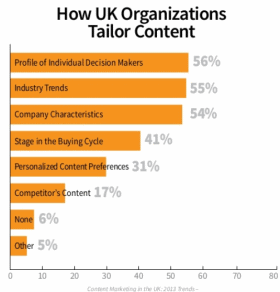 According to the Content Marketing Institute report about the usage of content marketing in the UK, 96% of UK B2B marketers tailor their marketing content. 88% of B2C respondents does the same. That looks great and UK marketers seem to do very well in this regard. However, is it really that good? What can you do to tailor your marketing content and get better content marketing results? The answer: a lot.
According to the Content Marketing Institute report about the usage of content marketing in the UK, 96% of UK B2B marketers tailor their marketing content. 88% of B2C respondents does the same. That looks great and UK marketers seem to do very well in this regard. However, is it really that good? What can you do to tailor your marketing content and get better content marketing results? The answer: a lot.
While the numbers, as found by the Content Marketing Institute may seem impressive, they are not really if you look closer. As a matter of fact, all content that is not tailored one way or the other is not marketing content. It’s just content, writing and multimedia without any purpose (writing is fun and great but in marketing it also serves a business goal). There is ample room for improvement as the research shows. And there certainly is in different areas the survey doesn’t cover. Find out why.
Non-tailored content is not marketing content
Marketing content is all content that is used, created, shared and curated for marketing goals. In other words: everything we do as content marketers and marketers in general from a content perspective involves marketing content, except user-generated content (until we use it for marketing purposes).
Marketing content is not just content with a marketing message in it. It’s also the content we create to answer the needs of target groups and buying personas throughout their different touchpoints, regardless of channels and format.
Some data from the mentioned UK content marketing survey. As you can see in the screenshot, the first way UK organizations tailor content is based on the profile of individual decision makers (56% of respondents). This is closely followed by industry trends (55%) and company characteristics (54%). The stages in the buying cycle of the target audiences are used by just 41% and personalized content preferences by only 31%. Finally, 17% looks at competitor’s content.
It’s striking that quite some tailoring (personalization, segmentation) happens based on parameters that are not related to the needs and quests of the target audiences but on criteria related to other factors. As such, these criteria are important too. However, when looking at the details of how UK businesses tailor their marketing content this way, the picture looks less rosy than the data I mentioned in the introduction. Many elements are missing or undervalued.
Essential criteria to tailor your marketing content
In fact, all marketing content should be tailored in at least one and ideally multiple ways. Segmenting, personalizing and tailoring content is part of every customer-centric and integrated content marketing process.
The three factors to take – at the very least – into account when tailoring marketing content are:
- The profile and needs of target audiences in different stages. There are dozens of ways to do this as will be explained in next posts in this series.
- The context. Content always lives in a broader context. Normally, with context I mean all external elements, including the just mentioned profiles and needs. However, here I use it in a more strict sense: time, device, preferred channels, you name it. Marketing content needs to be tailored this way too.
- The goals. I’m probably repeating myself but you really need to go in with a plan – a content strategy and content marketing strategy if you want – looking at how to tailor your content depending on your brand narrative and goals. This goes far beyond doing what competitors put out. While it’s always good to see what your competitors do, it’s more important to look at YOUR brand message, goals and – most of all – target audiences.

Tailoring marketing content can really be done in literally many dozens of ways, depending on among others channels and intent. Optimizing tweets, improving email content, creating winning B2B content strategies, boosting results of marketing content: it’s all a matter of tailoring and focusing on the elements that matter for YOUR goals and those of your audiences.
Non-tailored content is ineffective content. The more – relevant – ways you use to tailor it, the better your results will be. It’s a very customer-centric and multi-channel world out there and there is more possible than you might think. Effective content requires customer-centricity and ongoing optimization: that’s what customer-centric content optimization is all about.
If you wonder why the title of this post says ‘your tailor is rich’: “My tailor is rich but my English is poor” was the almost proverbial opening line to the Assimili English language learning method. Your marketing content can lead to much better results instead of poor results.
Tailored content is really the way to be more effective and customer-centric, and in the end rich. However, most of all: it will also make the experiences of your prospects, customers and target audiences rich.
Images purchased under license from Shutterstock

